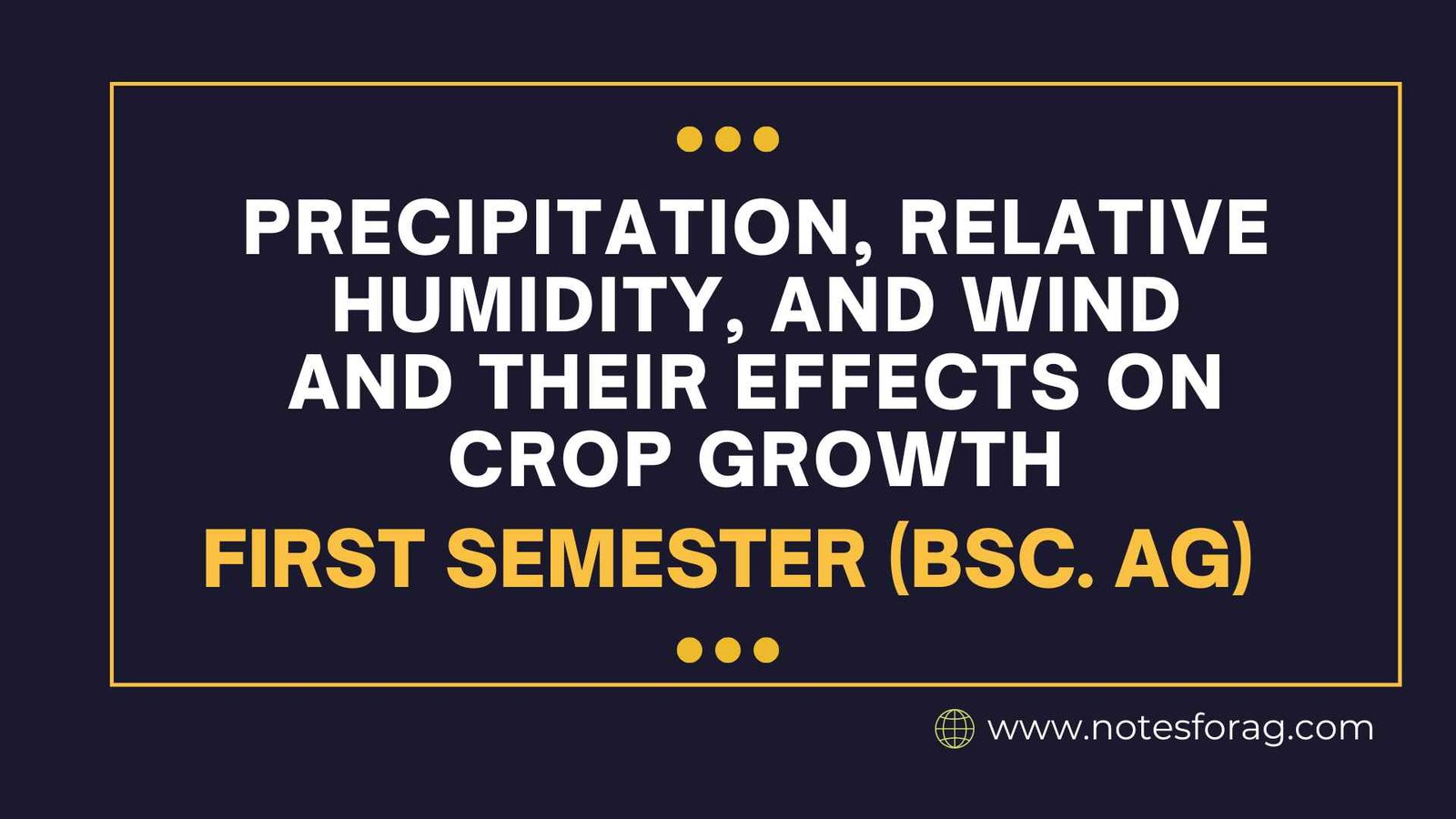Wind, relative humidity, and precipitation are three essential environmental elements that have a big impact on crop growth. Sufficient precipitation guarantees a supply of water for vital physiological functions, whereas relative humidity affects rates of transpiration and the incidence of diseases. Wind modifies transpiration, facilitates or impedes pollination, and may result in physical harm and soil erosion, among other effects on crops. Managing these variables through integrated methods, like crop selection, irrigation control, and protective structures, can maximize crop yields and improve the sustainability of agriculture.
Table of Contents
Precipitation
For crop growth,it is essential because it provides the main source of water required for plant growth. Photosynthesis, the uptake of nutrients, and the general health of plants all depend on water. The influence of it on crop growth, however, can differ greatly depending on the quantity and timing of rainfall.

Importance:
- Water Supply: Essential for photosynthesis, nutrient transport, and cellular activities.
- Soil Moisture: Affects root development and nutrient uptake.
Effects on Crop Growth:
- Adequate Precipitation: Encourages fruit setting, blooming, and robust growth.
- Excessive precipitation: May cause waterlogging, root rot, and a decrease in the amount of oxygen in the soil.
- Insufficient precipitation: This results in drought stress, which lowers photosynthesis, stunts growth, and produces a poor yield.
Relative Humidity
Crop growth and general health are greatly influenced by it. It is a measurement of the air’s moisture content in relation to the maximum moisture content that the air can hold at a specific temperature. Although the optimal humidity range varies by crop, most crops do best in a relative humidity range of 40% to 70%. While other crops may have different ideal humidity requirements, crops like tomatoes, cucumbers, and peppers thrive within this range.

Importance:
- Disease Development: Bacterial and fungal infections can be aided by high humidity levels.
- Transpiration Regulation: Affects the rate at which plant leaves lose water.
Effects on Crop Growth:
- High Relative Humidity:
- Lowers transpiration, which is advantageous when there is a shortage of water.
- Low Relative Humidity:
- Promotes transpiration, which, in the event of low soil moisture, can result in water stress.
Wind
It has a complex effect on crop development, affecting both positive and negative aspects of plant growth. While a little wind can help with pollination and pest control, a lot of wind can seriously hinder agricultural productivity. Comprehending these impacts is essential for maximizing agricultural output and putting in place efficient safeguards.

Importance:
- Pollination: Depending on the crop, it can help or hinder pollination.
- Temperature Control: By increasing transpiration and evaporation, it helps cool plants.
Effects on Crop Growth:
- Moderate Wind:
- Helps in the distribution of pollen for certain crops (e.g., cereals).
- Can reduce leaf temperature and mitigate heat stress.
- Strong Wind:
- Causes physical harm to plants, like lodging in cereals.
- Increases transpiration, which stresses the water supply.
- can cause soil erosion, which would lower the structure and fertility of the soil.
Integrated Effects
Relative humidity, wind, and precipitation all have complicated and interdependent combined effects. These elements need to be controlled using the right farming techniques in order to maximize crop growth:
- Irrigation Systems: To maintain appropriate soil moisture levels and supplement rainfall.
- Windbreaks and shelterbelts: To slow down wind and stop soil erosion.
- Humidity Control: Managing microclimate conditions through the use of strategies like mulching and shade nets.
- Disease Management: To combat diseases linked to high humidity, use crop rotation, resistant varieties, and the right fungicides.
Practical Applications
- Crop Selection: Selecting plants and cultivars that are compatible with the climate and weather of the area.
- Timing of Planting: To guarantee that ideal growth stages coincide with sufficient moisture availability, planting schedules should be coordinated with anticipated patterns of precipitation.
- Soil management: Increasing the amount of organic matter and improving the soil’s structure to better retain water and lessen erosion.
In order to maximize crop growth and attain sustainable agricultural productivity, it is crucial to comprehend the functions and interactions of wind, relative humidity, and precipitation. To reduce negative effects and improve favorable conditions, farmers and agronomists need to constantly monitor these factors and implement adaptive strategies.
Frequently Asked Question(FAQ)
How does relative humidity influence plant diseases?
High relative humidity fosters the growth of bacterial and fungal diseases, including rust and powdery mildew. Insufficient soil moisture can cause water stress due to increased transpiration rates, even though low humidity can lessen the pressure of disease.
What is the relationship between humidity and precipitation?
Precipitation and humidity have a close relationship; high humidity suggests there is more moisture in the air, which can cause clouds to form and raise the chance of precipitation.
Related Articles

